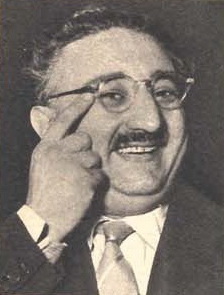Giovanni Leone facts for kids
Quick facts for kids
Giovanni Leone
|
|||||||||||||||||||||||||||
|---|---|---|---|---|---|---|---|---|---|---|---|---|---|---|---|---|---|---|---|---|---|---|---|---|---|---|---|
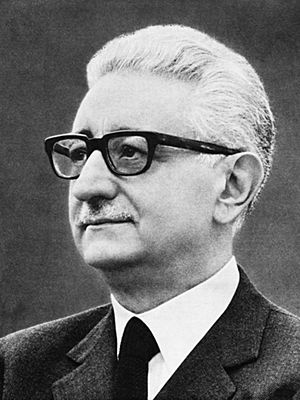
Official portrait, c. 1976
|
|||||||||||||||||||||||||||
| President of Italy | |||||||||||||||||||||||||||
| In office 29 December 1971 – 15 June 1978 |
|||||||||||||||||||||||||||
| Prime Minister | Emilio Colombo Giulio Andreotti Mariano Rumor Aldo Moro Giulio Andreotti |
||||||||||||||||||||||||||
| Preceded by | Giuseppe Saragat | ||||||||||||||||||||||||||
| Succeeded by | Sandro Pertini | ||||||||||||||||||||||||||
| Prime Minister of Italy | |||||||||||||||||||||||||||
| In office 25 June 1968 – 13 December 1968 |
|||||||||||||||||||||||||||
| President | Giuseppe Saragat | ||||||||||||||||||||||||||
| Preceded by | Aldo Moro | ||||||||||||||||||||||||||
| Succeeded by | Mariano Rumor | ||||||||||||||||||||||||||
| In office 22 June 1963 – 5 December 1963 |
|||||||||||||||||||||||||||
| President | Antonio Segni | ||||||||||||||||||||||||||
| Deputy | Attilio Piccioni | ||||||||||||||||||||||||||
| Preceded by | Amintore Fanfani | ||||||||||||||||||||||||||
| Succeeded by | Aldo Moro | ||||||||||||||||||||||||||
| President of the Chamber of Deputies | |||||||||||||||||||||||||||
| In office 10 May 1955 – 21 June 1963 |
|||||||||||||||||||||||||||
| Preceded by | Giovanni Gronchi | ||||||||||||||||||||||||||
| Succeeded by | Brunetto Bucciarelli-Ducci | ||||||||||||||||||||||||||
|
|||||||||||||||||||||||||||
| Personal details | |||||||||||||||||||||||||||
| Born | 3 November 1908 Naples, Kingdom of Italy |
||||||||||||||||||||||||||
| Died | 9 November 2001 (aged 93) Rome, Italy |
||||||||||||||||||||||||||
| Political party | DC (1944–1994) Independent (1994–2001) |
||||||||||||||||||||||||||
| Spouse |
Vittoria Michitto
(m. 1946) |
||||||||||||||||||||||||||
| Children | 4 | ||||||||||||||||||||||||||
| Alma mater | University of Naples Federico II | ||||||||||||||||||||||||||
| Signature | |||||||||||||||||||||||||||
Giovanni Leone (born November 3, 1908 – died November 9, 2001) was an Italian politician, jurist (a legal expert), and university professor. He helped start the Christian Democracy (DC) party. Leone served as the President of Italy from December 1971 to June 1978. He was also the Prime Minister of Italy twice, from June to December 1963 and again from June to December 1968. Before that, he was the president of the Chamber of Deputies from May 1955 to June 1963.
Leone was the first Italian president to step down because of a scandal. In 1978, he was accused of bribery. However, these accusations were later found to be false, and his good name was fully restored.
Contents
Early Life and Education
Giovanni Leone was born in Naples, Italy, in 1908. His parents were Mauro Leone and Maria Gioffredi. His father, Mauro Leone, was a well-known lawyer. Giovanni grew up in Pomigliano d'Arco, where he finished high school in 1924.
In 1929, he earned a law degree from the University of Naples Federico II. The next year, he also got a degree in social and political science. During his university years, Leone joined a group called Catholic Action. After graduating, he worked at a law firm and became a professor of criminal law at the University of Camerino.
In the 1930s, he became one of the most important lawyers and legal experts in Southern Italy. He taught at the Universities of Messina, Bari, and Naples. He also led the Italian section of the International Association of Penal Law.
During World War II, he worked as a magistrate (a type of judge) in Naples. He helped many political prisoners and soldiers who had left the army to be released. This saved them from danger during the Nazi occupation. In 1946, he married Vittoria Michitto. They had four sons: Mauro, Paolo, Giancarlo, and Giulio.
Political Journey
In 1943, Giovanni Leone helped create the Christian Democracy (DC) party. This party was led by Alcide De Gasperi. Two years later, in 1945, he became the DC's local secretary for Naples. He quickly became an important person in the party.
In 1946, Leone supported being "neutral" in the 1946 Italian institutional referendum. In this vote, Italians decided to end the monarchy and create a republic. In the same year, he was elected to the Constituent Assembly. This group was tasked with writing Italy's new constitution.
In April 1948, he was elected to the Chamber of Deputies. Even as a deputy, he continued his work as a lawyer and university professor. He often said that these jobs were more important to him. Leone was known for staying out of the party's internal disagreements. He was generally seen as being close to the party's more traditional side.
Leading the Chamber of Deputies
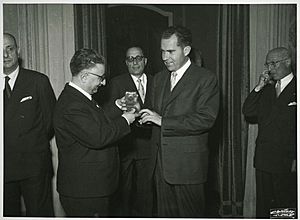
Because he was respected by all parts of his party and other political groups, Leone became the Vice President of the Chamber of Deputies in 1950. Then, in May 1955, he became the President of the Chamber. He held this important position until June 1963.
As president, he showed a strong respect for rules and democracy. He was very good at managing how Parliament worked. He earned respect from both his own party and other parties. They all appreciated his fair and balanced approach.
Serving as Prime Minister
First Time as Prime Minister
In the 1963 election, the Christian Democrats lost some votes. On June 22, 1963, Giovanni Leone was chosen to lead a temporary government.
Leone formed a government made up only of Christian Democracy members. Other parties, like the Italian Socialist Party (PSI), supported his government from outside. This government was called the "Bridge Government." It was meant to be a step towards closer cooperation with the Socialist Party.
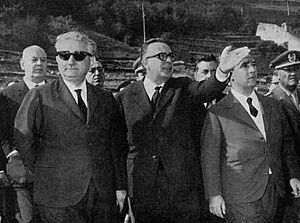
As Prime Minister, Leone had to deal with a terrible event: the Vajont Dam disaster. On October 9, 1963, a huge landslide happened near the Vajont Dam. This caused a giant wave of water to spill over the dam. The wave destroyed several villages and towns, killing 1,917 people.
After the disaster, the government said it was an unexpected natural event. However, there had been warnings and signs of danger before. In December 1963, after only five months, Leone resigned. Aldo Moro became the new Prime Minister.
1964 Presidential Election
In August 1964, President Antonio Segni became very ill and decided to resign. Leone was chosen as the Christian Democracy's candidate for president. However, he did not win. Instead, Giuseppe Saragat became president.
In August 1967, President Saragat made Leone a Senator for Life. This meant he would be a senator for the rest of his life.
Second Time as Prime Minister
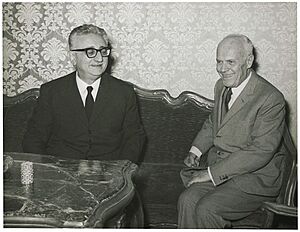
In June 1968, after the general election, President Saragat asked Leone to lead the government again. His second government was also made up only of Christian Democracy members.
In November 1968, a new law was passed. It helped workers in the industrial sector who lost their jobs. It gave them money if companies closed down or had large layoffs.
Leone's second time as Prime Minister lasted only seven months. In December 1968, he resigned, and Mariano Rumor became the new Prime Minister.
President of Italy (1971–1978)
In 1971, Giovanni Leone was chosen as the Christian Democracy candidate for President of the Republic. After many rounds of voting, he was finally elected on the twenty-third try. He won with 518 votes out of 996. This was a very close election and the longest presidential election in Italian history.
Leone's wife, Vittoria, played a new and important role as the First Lady. Before her, the wives of Italian presidents usually stayed out of politics. Vittoria Leone changed this and became a very visible First Lady.
During his time as president, Italy faced many difficult political and social challenges. Early in his term, he had to approve the early end of Parliament. This was the first time this had happened since Italy became a republic.
The Kidnapping of Aldo Moro
On March 16, 1978, Aldo Moro, who was the leader of the Christian Democracy party, was kidnapped. A group called the Red Brigades (BR) attacked his car in Rome. They killed his bodyguards and took him.
Moro was held for 55 days. During this time, he was put on a "trial" by the Red Brigades. On May 9, 1978, Moro's body was found in the trunk of a car in Rome.
Later Life and Recognition
After he resigned as president, Giovanni Leone continued to serve in Parliament as a Senator for life. He wrote and gave interviews to explain his actions as President. He also showed that the accusations against him were false.
Many politicians who had criticized him later apologized. For example, Marco Pannella and Emma Bonino publicly expressed their regrets on Leone's 90th birthday.
On September 25, 2001, just before his 93rd birthday, he was given the title of President Emeritus of the Republic. This title would also be given to all future former presidents.
Giovanni Leone passed away in Rome on November 9, 2001. On November 25, 2006, President Giorgio Napolitano announced that the Senate had fully recognized that Leone's actions were correct. This completely restored his political reputation.
Giovanni Leone was shown as a character in the 2020 film Rose Island. The movie tells the story of the Republic of Rose Island. Leone was played by Luca Zingaretti in the film.
Electoral History
| Election | House | Constituency | Party | Votes | Result | |
|---|---|---|---|---|---|---|
| 1946 | Constituent Assembly | Naples–Caserta | DC | 31,962 | ||
| 1948 | Chamber of Deputies | Naples–Caserta | DC | 60,007 | ||
| 1953 | Chamber of Deputies | Naples–Caserta | DC | 66,165 | ||
| 1958 | Chamber of Deputies | Naples–Caserta | DC | 206,182 | ||
| 1963 | Chamber of Deputies | Naples–Caserta | DC | 160,498 | ||
Presidential Elections
| 1971 presidential election (23rd ballot) | ||||
|---|---|---|---|---|
| Candidate | Party | Votes | % | |
| Giovanni Leone | Christian Democracy | 518 | 51.4 | |
| Pietro Nenni | Italian Socialist Party | 408 | 40.5 | |
| Others / Invalid votes | 82 | 8.1 | ||
| Total | 1,008 | 100.0 | ||
Images for kids
See also
 In Spanish: Giovanni Leone para niños
In Spanish: Giovanni Leone para niños


